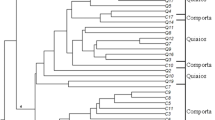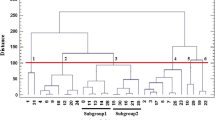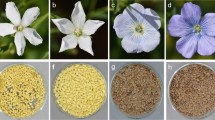Abstract
Wolfiporia cocos, a well-known medicinal fungus, has been widely used in China and other Asian countries due to its various therapeutic value. In this study, genetic diversity among 22 Chinese W. cocos cultivars were assessed using phenotypic traits and inter-simple sequence repeat (ISSR). The results demonstrated that a total of 686 bands were amplified by 17 selected primers, 81.9 % of which were found to be polymorphic. Genetic distance was from 1.05 to 7.62 (physiological characters), and the similarity coefficients were from 0.63 to 0.82 (ISSR). Both methods were effective in differentiating among strains. The unweighted pair-group method with arithmetic averages (UPGMA) dendrogram classified the 22 strains into six major groups. Comprehensive analysis indicated that the cultivated germplasm of W. cocos in China were rich in genetic diversity. The results of this study has contributed substantially to our knowledge of W. cocos genetic diversity and also provides a theoretical basis of use and conservation for W. cocos resource and breeding.


Similar content being viewed by others
References
Dai YC, Yang ZL, Cui BK, Yu CJ, Zhou LW (2009) Species diversity and utilization of medicinal mushrooms and fungi in China. Int J Med Mushrooms 11:287–302
Esteban CI (2009) Medicinal interest of Poria cocos ( = Wolfiporia extensa). Rev Iberoam Micol 26:103–107
Fu J, Wang KQ, Su W, Fang H, Deng F (2002) Review of Chinese traditional medicinal fungus: Wolfiporia cocos. Res Inf Tradit Chin Med 4:16–17
Kubo T, Terabayashi S, Takeda S, Sasaki H, Aburada M, Miyamoto K (2006) Indoor cultivation and cultural characteristics of Wolfiporia cocos sclerotia using mushroom culture bottles. Biol Pharm Bull 29:1191–1196
Legendre P, Fortin MJ (2010) Comparison of the Mantel test and alternative approaches for detecting complex multivariate relationships in the spatial analysis of genetic data. Mol Ecol Resour 10:831–844
Pawlik A, Janusz G, Debska I, Siwulski M, Frac M, Rogalski J (2015) Genetic and metabolic intraspecific biodiversity of Ganoderma lucidum. BioMed Res Int. doi:10.1155/2015/726149
Peng L, Ru M, Wang BQ, Wang Y, Li B, Yu J, Liang ZS (2014) Genetic diversity assessment of a germplasm collection of Salvia miltiorrhiza Bunge. based on morphology, ISSR and SRAP markers. Biochem Syst Ecol 55:84–92
Rampersad SN (2013) Genetic structure of Colletotrichum gloeosporioides sensu lato isolates infecting papaya inferred by multilocus ISSR markers. Phytopathology 103:182–189
Rios JL (2011) Chemical constituents and pharmacological properties of Poria cocos. Planta Med 77:681–691
Rohlf FJ (2000) NTSYS-PC numerical taxonomy and multivariate analysis system, version 2.10. Exeter Software, New York
Sambrook J, Russell DW (2001) Molecular cloning: a laboratory manual, 3rd edn. Cold Spring Harbor Laboratory Press, Cold Spring Harbor
Sharma M, Gupta SK, Sharma TR (2005) Characterization of variability in Rhizoctonia solani by using morphological and molecular markers. J Phytopathol 153:449–456
Tang L, Xiao Y, Li L, Guo Q, Bian Y (2010) Analysis of genetic diversity among Chinese Auricularia auricula cultivars using combined ISSR and SRAP markers. Curr Microbiol 61:132–140
Tao J, Qiao G, Wen XP, Gao GL, Liu T, Peng ZJ, Cai YQ, Chen N, Yan FX, Zhang BX (2014) Characterization of genetic relationship of dragon fruit accessions (Hylocereus spp.) by morphological traits and ISSR markers. Sci Hortic 170:82–88
Wang YZ, Li T, Zhao YL, Zhang J, Liu HG (2012a) Contents of some metabolites in the peel and flesh of the medicinal mushroom Wolfiporia cocos (F.A. Wolf) Ryvarden et Gilb. (Higher Basidiomycetes). Int J Med Mushrooms 14:79–83
Wang K, Yin X, Huang H, Fu J, Feng H, Wang Q, Sun G (2012b) Production status and industrialization development countermeasures of Poria in Hubei Province. Mod Chin Med 14:24–27
Wang Y, Zhang J, Zhao Y, Li T, Shen T, Li J, Li W, Liu H (2013) Mycology, cultivation, traditional uses, phytochemistry and pharmacology of Wolfiporia cocos (Schwein.) Ryvarden et Gilb.: a review. J Ethnopharmacol 147:265–276
Xing X, Ma X, Hart MM, Wang A, Guo S (2013) Genetic diversity and evolution of Chinese traditional medicinal fungus Polyporus umbellatus (Polyporales, Basidiomycota). PLoS ONE 8, e58807
Xiong J, Lin FC, Wang KQ, Su W, Fu J (2006) Studies on Basic biological characters of Wolfporia cocos. Mycosystema 25:446–453
Xu Z, Tang W, Xiong B, Wang K, Bian Y (2014) Effect of revulsive cultivation on the yield and quality of newly formed sclerotia in medicinal Wolfiporia cocos. J Nat Med 68:576–585
Yeh FC, Yang R-C, Boyle TBJ, Ye Z-H, Mao JX (1997) POPGENE, the user-friendly shareware for population genetic analysis. Molecular Biology and Biotechnology Centre. University of Alberta, Canada
Yin Y, Liu Y, Li H, Zhao S, Wang S, Liu Y, Wu D, Xu F (2014) Genetic diversity of Pleurotus pulmonarius revealed by RAPD, ISSR, and SRAP fingerprinting. Curr Microbiol 68:397–403
Zhang J, Wu MD, Li GQ, Yang L, Yu L, Jiang DH, Huang HC, Zhuang WY (2010) Botrytis fabiopsis, a new species causing chocolate spot of broad bean in central China. Mycologia 102:1114–1126
Zhang QS, Xu BL, Liu LD, Yuan QQ, Dong HX, Cheng XH, Lin DL (2012) Analysis of genetic diversity among Chinese Pleurotus citrinopileatus Singer cultivars using two molecular marker systems (ISSRs and SRAPs) and morphological traits. World J Microbiol Biotechnol 28:2237–2248
Zhou YJ, Zhang J, Wang XD, Yang L, Jiang DH, Li GQ, Hsiang T, Zhuang WY (2014) Morphological and phylogenetic identification of Botrytis sinoviticola, a novel cryptic species causing gray mold disease of table grapes (Vitis vinifera) in China. Mycologia 106:43–56
Zietkiewicz E, Rafalski A, Labuda D (1994) Genome fingerprinting by simple sequence repeat (SSR)-anchored polymerase chain reaction amplification. Genomics 20:176–183
Acknowledgments
We thank the anonymous reviewers for their constructive and helpful comments. This research was supported by the State of Traditional Chinese Medicine Industry Research Program (No. 201107009).
Author information
Authors and Affiliations
Corresponding authors
Additional information
Section Editor: Marc Stadler
Qiao Sun and Wei Wei share joint first authorship.
Qiao Sun and Wei Wei contributed equally to this work.
Rights and permissions
About this article
Cite this article
Sun, Q., Wei, W., Zhu, W. et al. Genetic diversity of Chinese Wolfiporia cocos cultivars revealed by phenotypic traits and ISSR markers. Mycol Progress 14, 61 (2015). https://doi.org/10.1007/s11557-015-1088-1
Received:
Revised:
Accepted:
Published:
DOI: https://doi.org/10.1007/s11557-015-1088-1




